[English] 日本語
 Yorodumi
Yorodumi- PDB-4lwg: Crystal Structure of the human Hsp90-alpha N-domain bound to the ... -
+ Open data
Open data
- Basic information
Basic information
| Entry | Database: PDB / ID: 4lwg | ||||||
|---|---|---|---|---|---|---|---|
| Title | Crystal Structure of the human Hsp90-alpha N-domain bound to the hsp90 inhibitor FJ4 | ||||||
 Components Components | Heat shock protein HSP 90-alpha | ||||||
 Keywords Keywords | CHAPERONE / Rossmann Fold / ATP Binding / molecularchaperone | ||||||
| Function / homology |  Function and homology information Function and homology informationsperm mitochondrial sheath / sulfonylurea receptor binding / dATP binding / CTP binding / positive regulation of protein polymerization / Scavenging by Class F Receptors / vRNP Assembly / UTP binding / sperm plasma membrane / chaperone-mediated autophagy ...sperm mitochondrial sheath / sulfonylurea receptor binding / dATP binding / CTP binding / positive regulation of protein polymerization / Scavenging by Class F Receptors / vRNP Assembly / UTP binding / sperm plasma membrane / chaperone-mediated autophagy / Rho GDP-dissociation inhibitor binding / Respiratory syncytial virus genome replication / telomerase holoenzyme complex assembly / mitochondrial transport / Uptake and function of diphtheria toxin / Drug-mediated inhibition of ERBB2 signaling / Resistance of ERBB2 KD mutants to trastuzumab / Resistance of ERBB2 KD mutants to sapitinib / Resistance of ERBB2 KD mutants to tesevatinib / Resistance of ERBB2 KD mutants to neratinib / Resistance of ERBB2 KD mutants to osimertinib / Resistance of ERBB2 KD mutants to afatinib / Resistance of ERBB2 KD mutants to AEE788 / Resistance of ERBB2 KD mutants to lapatinib / Drug resistance in ERBB2 TMD/JMD mutants / protein import into mitochondrial matrix / TPR domain binding / dendritic growth cone / Assembly and release of respiratory syncytial virus (RSV) virions / PIWI-interacting RNA (piRNA) biogenesis / non-chaperonin molecular chaperone ATPase / Sema3A PAK dependent Axon repulsion / protein unfolding / regulation of protein ubiquitination / positive regulation of cell size / HSF1-dependent transactivation / response to unfolded protein / enzyme-substrate adaptor activity / HSF1 activation / skeletal muscle contraction / regulation of protein-containing complex assembly / telomere maintenance via telomerase / Attenuation phase / chaperone-mediated protein complex assembly / regulation of postsynaptic membrane neurotransmitter receptor levels / axonal growth cone / neurofibrillary tangle assembly / RHOBTB2 GTPase cycle / positive regulation of lamellipodium assembly / nitric oxide metabolic process / eNOS activation / Tetrahydrobiopterin (BH4) synthesis, recycling, salvage and regulation / DNA polymerase binding / positive regulation of defense response to virus by host / response to salt stress / Signaling by ERBB2 / positive regulation of telomere maintenance via telomerase / cardiac muscle cell apoptotic process / endocytic vesicle lumen / positive regulation of cardiac muscle contraction / Loss of Nlp from mitotic centrosomes / Loss of proteins required for interphase microtubule organization from the centrosome / Recruitment of mitotic centrosome proteins and complexes / activation of innate immune response / lysosomal lumen / Recruitment of NuMA to mitotic centrosomes / Anchoring of the basal body to the plasma membrane / positive regulation of interferon-beta production / protein tyrosine kinase binding / response to cold / ESR-mediated signaling / HSP90 chaperone cycle for steroid hormone receptors (SHR) in the presence of ligand / Constitutive Signaling by Overexpressed ERBB2 / AURKA Activation by TPX2 / nitric-oxide synthase regulator activity / VEGFR2 mediated vascular permeability / response to cocaine / DDX58/IFIH1-mediated induction of interferon-alpha/beta / ATP-dependent protein folding chaperone / Regulation of necroptotic cell death / brush border membrane / Signaling by ERBB2 TMD/JMD mutants / Constitutive Signaling by EGFRvIII / Downregulation of ERBB2 signaling / Signaling by ERBB2 ECD mutants / Signaling by ERBB2 KD Mutants / Chaperone Mediated Autophagy / Regulation of actin dynamics for phagocytic cup formation / cellular response to virus / Aggrephagy / positive regulation of protein import into nucleus / tau protein binding / VEGFA-VEGFR2 Pathway / response to estrogen / histone deacetylase binding / The role of GTSE1 in G2/M progression after G2 checkpoint / neuron migration / Regulation of PLK1 Activity at G2/M Transition / positive regulation of protein catabolic process / positive regulation of nitric oxide biosynthetic process Similarity search - Function | ||||||
| Biological species |  Homo sapiens (human) Homo sapiens (human) | ||||||
| Method |  X-RAY DIFFRACTION / X-RAY DIFFRACTION /  SYNCHROTRON / SYNCHROTRON /  MOLECULAR REPLACEMENT / Resolution: 1.599 Å MOLECULAR REPLACEMENT / Resolution: 1.599 Å | ||||||
 Authors Authors | Li, J. / Shi, F. / Xiong, B. / He, J. | ||||||
 Citation Citation |  Journal: Eur.J.Med.Chem. / Year: 2014 Journal: Eur.J.Med.Chem. / Year: 2014Title: Discovery of potent N-(isoxazol-5-yl)amides as HSP90 inhibitors. Authors: Chen, D. / Shen, A. / Li, J. / Shi, F. / Chen, W. / Ren, J. / Liu, H. / Xu, Y. / Wang, X. / Yang, X. / Sun, Y. / Yang, M. / He, J. / Wang, Y. / Zhang, L. / Huang, M. / Geng, M. / Xiong, B. / Shen, J. | ||||||
| History |
|
- Structure visualization
Structure visualization
| Structure viewer | Molecule:  Molmil Molmil Jmol/JSmol Jmol/JSmol |
|---|
- Downloads & links
Downloads & links
- Download
Download
| PDBx/mmCIF format |  4lwg.cif.gz 4lwg.cif.gz | 100.7 KB | Display |  PDBx/mmCIF format PDBx/mmCIF format |
|---|---|---|---|---|
| PDB format |  pdb4lwg.ent.gz pdb4lwg.ent.gz | 76.5 KB | Display |  PDB format PDB format |
| PDBx/mmJSON format |  4lwg.json.gz 4lwg.json.gz | Tree view |  PDBx/mmJSON format PDBx/mmJSON format | |
| Others |  Other downloads Other downloads |
-Validation report
| Summary document |  4lwg_validation.pdf.gz 4lwg_validation.pdf.gz | 769.2 KB | Display |  wwPDB validaton report wwPDB validaton report |
|---|---|---|---|---|
| Full document |  4lwg_full_validation.pdf.gz 4lwg_full_validation.pdf.gz | 771.2 KB | Display | |
| Data in XML |  4lwg_validation.xml.gz 4lwg_validation.xml.gz | 11.2 KB | Display | |
| Data in CIF |  4lwg_validation.cif.gz 4lwg_validation.cif.gz | 15.2 KB | Display | |
| Arichive directory |  https://data.pdbj.org/pub/pdb/validation_reports/lw/4lwg https://data.pdbj.org/pub/pdb/validation_reports/lw/4lwg ftp://data.pdbj.org/pub/pdb/validation_reports/lw/4lwg ftp://data.pdbj.org/pub/pdb/validation_reports/lw/4lwg | HTTPS FTP |
-Related structure data
| Related structure data |  4lweC  4lwfC  4lwhC  4lwiC 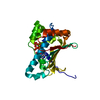 3t0zS C: citing same article ( S: Starting model for refinement |
|---|---|
| Similar structure data |
- Links
Links
- Assembly
Assembly
| Deposited unit | 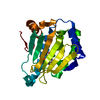
| ||||||||
|---|---|---|---|---|---|---|---|---|---|
| 1 |
| ||||||||
| Unit cell |
|
- Components
Components
| #1: Protein | Mass: 23263.402 Da / Num. of mol.: 1 / Fragment: UNP RESIDUES 17-224 Source method: isolated from a genetically manipulated source Source: (gene. exp.)  Homo sapiens (human) / Gene: HSP90AA1, HSP90A, HSPC1, HSPCA / Production host: Homo sapiens (human) / Gene: HSP90AA1, HSP90A, HSPC1, HSPCA / Production host:  |
|---|---|
| #2: Chemical | ChemComp-FJ4 / |
| #3: Water | ChemComp-HOH / |
-Experimental details
-Experiment
| Experiment | Method:  X-RAY DIFFRACTION / Number of used crystals: 1 X-RAY DIFFRACTION / Number of used crystals: 1 |
|---|
- Sample preparation
Sample preparation
| Crystal | Density Matthews: 3.06 Å3/Da / Density % sol: 59.79 % |
|---|---|
| Crystal grow | Temperature: 277 K / Method: vapor diffusion, hanging drop / pH: 6.5 Details: 20-25% (w/v) PEG 2000 monomethyl ether, 200mM magnesium chloride, 100mM sodium cacodylate pH 6.5, VAPOR DIFFUSION, HANGING DROP, temperature 277K |
-Data collection
| Diffraction | Mean temperature: 100 K |
|---|---|
| Diffraction source | Source:  SYNCHROTRON / Site: SYNCHROTRON / Site:  SSRF SSRF  / Beamline: BL17U / Beamline: BL17U |
| Detector | Type: ADSC QUANTUM 315r / Detector: CCD |
| Radiation | Monochromator: 0.97907 / Protocol: SINGLE WAVELENGTH / Monochromatic (M) / Laue (L): M / Scattering type: x-ray |
| Radiation wavelength | Relative weight: 1 |
| Reflection | Resolution: 1.599→32.987 Å / Num. obs: 38053 / % possible obs: 98.9 % / Observed criterion σ(F): 2 / Observed criterion σ(I): 2 / Redundancy: 7.3 % / Rmerge(I) obs: 0.065 / Rsym value: 0.065 / Net I/σ(I): 50.746 |
- Processing
Processing
| Software |
| ||||||||||||||||||||||||||||||||||||||||||||||||||||||||||||||||||
|---|---|---|---|---|---|---|---|---|---|---|---|---|---|---|---|---|---|---|---|---|---|---|---|---|---|---|---|---|---|---|---|---|---|---|---|---|---|---|---|---|---|---|---|---|---|---|---|---|---|---|---|---|---|---|---|---|---|---|---|---|---|---|---|---|---|---|---|
| Refinement | Method to determine structure:  MOLECULAR REPLACEMENT MOLECULAR REPLACEMENTStarting model: 3T0Z Resolution: 1.599→32.987 Å / SU ML: 0.21 / σ(F): 0 / Phase error: 21.83 / Stereochemistry target values: ML
| ||||||||||||||||||||||||||||||||||||||||||||||||||||||||||||||||||
| Solvent computation | Shrinkage radii: 0.95 Å / VDW probe radii: 1.2 Å / Solvent model: FLAT BULK SOLVENT MODEL / Bsol: 59.098 Å2 / ksol: 0.4 e/Å3 | ||||||||||||||||||||||||||||||||||||||||||||||||||||||||||||||||||
| Displacement parameters |
| ||||||||||||||||||||||||||||||||||||||||||||||||||||||||||||||||||
| Refinement step | Cycle: LAST / Resolution: 1.599→32.987 Å
| ||||||||||||||||||||||||||||||||||||||||||||||||||||||||||||||||||
| Refine LS restraints |
| ||||||||||||||||||||||||||||||||||||||||||||||||||||||||||||||||||
| LS refinement shell | Refine-ID: X-RAY DIFFRACTION / Total num. of bins used: 10
|
 Movie
Movie Controller
Controller


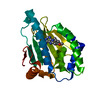
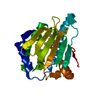
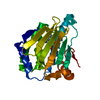
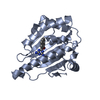

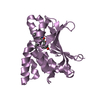

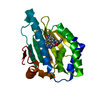
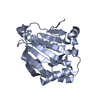
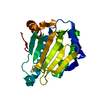
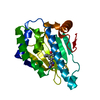
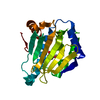

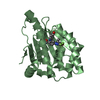


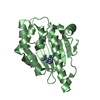
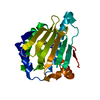
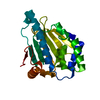
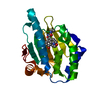
 PDBj
PDBj






















